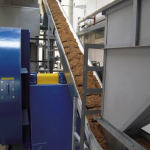Equipment for drying substances with a high moisture content
TENZA a.s. with financial assistance of the Ministry of Industry and Commerce of the Czech Republic has developed and run the trial of a new technology for drying substances with a very high moisture content. The equipment employs the technology of closed-circuit thermal moisture separation so that the return on input thermal energy may exceed 90%.
Thermal drying is an energy-intensive process. Until recently the possibility of reusing output heat remaining after drying and having temperatures suitable for further use was not considered when dealing with the issue of drying materials with a very high moisture content. However, the new developments in closed-circuit drying enable operators to reuse the output heat produced by the drying equipment for other technological purposes, which is certainly a cost-effective technical solution. The dryer can be included in the production or peripheral processes taking place at the operator’s facility either as a separate equipment or in connection with other suitable equipment (e.g. combustion).
Substances to be dried
Raw material, intermediate or semi-finished product or waste where the percentage of water by weight may exceed 80% which water can be heated to a temperature of 100 – 110˚C.
The equipment can be installed where:
- there is a problem with separating a high moisture content,
- moisture separation technology is capital intensive,
- it is possible to reuse heat having temperatures of up to 100˚C,
- it is suitable or necessary to sanitize the dried substance,
- improved handling and storage of the dried material is required,
- the dried material can be used as fuel (if the dry matter contains combustible material),
- it is desirable to reduce or possibly prevent emissions of odorous compounds.
The outgoing heat can be used for
- heating in the 90/70 ˚C systems
- direct heating
- generating technological heat
- cooling
- water heating
- drying using a different temperature drop etc.
Examples of using the equipment
- draff drying
- stillage drying
- drying of sludge from wastewater treatment plants
- sanitation of sludge from wastewater treatment plants
- drying of biomass with a high moisture content
Description
The Exchanger
The exchanger is equipped with a system of pipes having the necessary heat-exchanging area and ensuring that heat contained in steam is transferred to the layer of substance being dried.
The Fan
The fan ensures air circulation in the internal closed circle of the drier and keeps the layer of dried substance within the required zone. The fan can be operated manually from the control panel or automatically.
Separated Moisture Condenser
It is a steam-water exchanger where the separated moisture condenses in the form of steam having a temperature of approx. 108˚C. Its design makes cleaning easy, which is necessary as the steam (i.e. moisture originally contained in the raw material) is polluted and can block the heat-exchanging area of the condenser.
Connecting Parts of the Closed Circuit
The parts including accessories connect the internal circuit, make it airtight and make thermal expansion possible without transferring pressures between individual assembly units. They are fitted with necessary meters and regulators.
Screw Conveyors
The screw conveyors transport the moist raw material to the space with the fluid layer and empty the dry material container while preserving the tightness of the internal circuit. The conveyors make continuous drying in the fluid layer possible thanks to smooth output regulation.
The other parts of the drying equipment include media distribution pipes, raw material containers, a belt conveyor, electrical connections and a system of meters and regulators, and possibly a sludge feeder.
Example:
A substance with a moisture content of 80% (heating capacity 1.1 MJ/kg) is being dried to have the residual moisture content of 13% (the heating capacity of the dry matter being 17.4 MJ/kg).
By drying 300 kg of such moist substance, we increase the usable power in the dry matter, in the output steam and the condenser by 1 GJ.
Gallery
Want to know more? Contact us!



